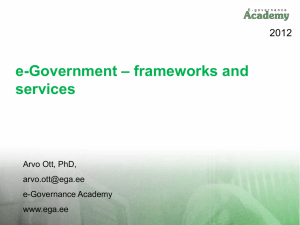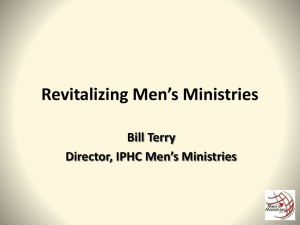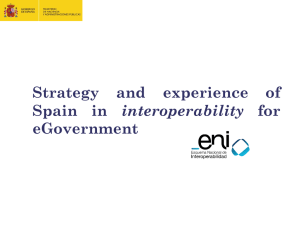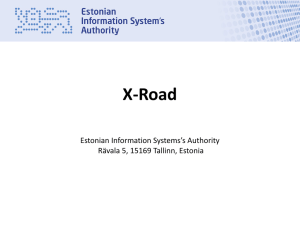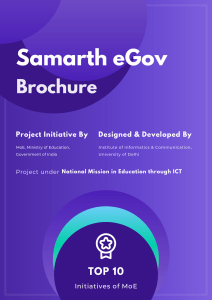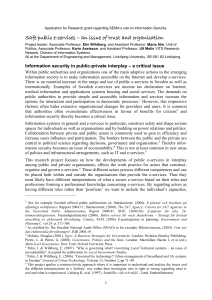The Development of e- Governance. Building Blocks and Frameworks: Information Policy,
advertisement
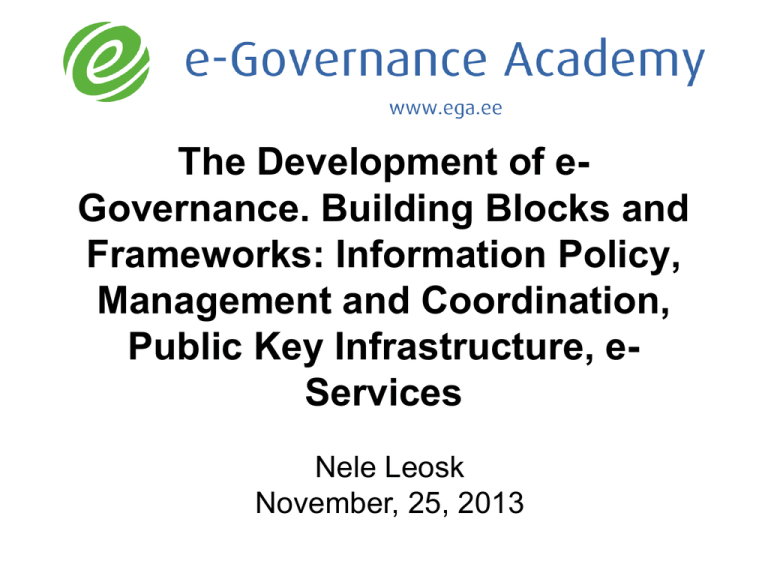
The Development of eGovernance. Building Blocks and Frameworks: Information Policy, Management and Coordination, Public Key Infrastructure, eServices Nele Leosk November, 25, 2013 Where e-Estonia? What is e-Governance Acedemy? • Non profit think tank founded for the creation and transfer of knowledge concerning egovernance, e-democracy and the development of civil society • by OSI, UNDP and Estonian Government in 2002 • Network-based organisation (national and international experts, practicioners) What is e-governance? IT/GDP and IT/per capita Readiness 2003 Readiness 2009 E-Government Some landmarks Examples of e-services: e-declarations Example of e-services: Parental benefit 18 data requests between 5 information systems + calculation = 7 documents in real life = 3 minutes data input +1 mouse click Organisational framework I N F O R M A T I O N P O L I C Y C O A L I T I O N A G R E E M E N T A C T I O N P L A N Parliament Government Ministries Informatics Council Example: Info-political principles in Estonia • Citizen (customer) orientation • Leading role for the private sector • Efficient and transparent public sector. eDemocracy and participation. • Functioning model for protection of personal data • Measures against digital divide (ID-cards example…) • Neutrality concerning technological platforms • etc. Progress. Public Service Model 1(byrocratic state+Internet) Public Service Model II (One stop shop) Public Service Model III (24/7 self service) Example of Action Plan: Document management and digital archives • All life-cycle of documents is digital in gov • • sector, preconditions for long-term archiving of digital documents Responsible: State Chancellery Actions: – Document management as part of interoperability framework – Infrastructure for digital archiving Organization Legal framework Fiscal framework eGovernment Policy / Strategy Technical architecture State Chancellery / Ministry eGov Center (CIO office) ICT work group of ministries ICT work group of regional development •Regulation initiatives •eGov budget planning •monitoring of implementation •Interoperability Framework agreements Ministries Reform initiatives ICT Budget CIO-s eGov implementing institution IT Businesses IT Businesses IT Businesses IT Businesses project procurement, supervision, implementation systems maintenance end user training Nature of document Name of Document Nature of regulation Policy and strategy documents eGov Strategy, Interoperability Framework Infopolitical agreement, strong recommendation Laws and sub-acts Databases acts, Personal Data Protection Act, Digital Signature Act etc. Compulsory Framework descriptions Architecture descriptions Strong recommendation Interoperability Related Standards Advise and recommendation Documents, digital signature, security, message transfer etc. Budgeting • Separate article of state budget: expenses for ITsubdivided into HW, SW and project work ordered from outside of government structures. For the last 8 years this budget has formed about 1% of the state budget. • All ministries, county governments and boards have independent IT budgets which are planned in cooperation of all CIOs. • For joint actions of several ministries the IT budget is often included in the budget of the ministry that is coordinating the work. E-Government infrastructure Electronic Identity: • Authentication of a user by digital certificate imbedded in the ID card or SIM card Digitalized information: Formalized exchange: • Information systems and databases in all levels of government • X- road - the connection of government databases by a data exchange service layer X-Road Estonia 110 DB 5 550 org. ~ 400 ~ 45 000 13 000 April 2010 www.ega.ee 1,100,000 500 DB e-Factory e-Energy e-Parlament e-Banking x-Road Center e-Health e-School e-Identity The central components in the architecture: • Government network GovNet • The Data Exchange Layer; • The layer of personalized portals (citizen portal(s), entrepreneur portal(s), civil servant(s) portals); • The register of registers, catalogue of services and the management system for the state information system; • The layer of geoinformation systems; • The layer of document management systems and document exchange centre; • The system of classifications; • The system of address details; • The security system National chip-based Identity Card Issuing authority: Estonian Citizenship and Migration Board Service contractor: TRÜB Switzerland Start of issue:January 1, 2002 Conformance with: ICAO Doc. 9303 part 3 Inside 16 Kb RSA crypto chip are : 2 private keys; authentication certificate; digital signature certificate; personal data file National e-services portal Some conclusions • Cooperation and coordination is the key, technology is the simplest part; • Important role of Centre in coordination of the actions; • Training of CIO-s (IT managers) and partners from private sector; • Medium push from legal framework; • Figuring out what might be the motivation; • Step-by-step approach, no need to enter to “business” of the “back-office” Some conclusions • Process from operational technical system to wide implementation takes 2-3 years – “honeymoon period” of the project • Money, spent once for development of basic components of the architecture will give high profit in the phase of development of single eservices… but it will be clear only after several years… and this might not be the motivation for public institutions • Driving force is often not from the top management of public institution but somewhere else – find this person … Thank you! nele.leosk@eui.eu Skype: neleleosk

